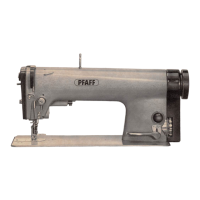12.
Varying
the
Top
Feed
Stroke
Depending
on
the
type
of
work
being
performed,
the
stroke
of
the
vibrating
presser
is
Increased
or
decreased
in
relation
to
the
stroke
of
the
feed
dog
by
turning
thumb
screw
A
(Fig.
17)
which
is
located
under
the
bedplate.
For
easy
identification,
this
screw
has
a
concave
surface.
Before varying the stroke of the vibrating presser by hand,
thumb
screw
B should be
turned
out
as far
as
it will
go.
Screw
B is
the
same
size
as
screw
A,
but
differs from
screw
A in
that
it
has
a
convex
surface.
Turn
in
screw
A to
increase
the
stroke
of
the
vibrating
presser,
or
turn
it
out,
to
decrease
it.
As
screw
A is
turned
in,
pointer
z
swings
to
the
left
(toward
+)
and
the
top
ply is
gathered.
It
should
be
noted,
however,
that
screw
A
must
not
be
turned
in
beyond
the
point
at
which
reverse feed control p
begins
to swing
downward.
This is
the
point at
which
the
stroke of
the
feed
dog,
which
is
identical
with
the
stitch
length,
begins
to
grow
shorter.
When turning screw A out, pointer z swings to the right, (toward
-)
and the top ply is stretched
(Fig.
16).
Bydecreasing the top feed stroke and thereby retarding the feeding of the top ply it is possible
to
gather
the
bottom
ply to
some
extent.
It
should
be
noted
that
screw
A
cannot
be
turned
in
when
the
machine
has
been
set
for
its
maximum
stitch
length
of S'A per inch, or
4.5
mm.
Thumb
screw
B
serves
to limit
the
stroke
of
the
vibrating
presser
and
is
used
when
this
stroke
is varied by foot action while sewing. Thumb screw A determines the length of travel of the
vibrating presser when the small treadle is inoperative, i.e. the more screw A is turned out,
the
shorter
the
stroke of
the
vibrating presser will be. As
the
tip of the small treadle is
depressed,
the stroke of the vibrating presser increases until it reaches its maximum of about Vi6", or
4.5 mm,
when
the
treadle is
depressed
completely. By turning
thumb
screw
B,
the
stroke of
the vibrating presser can be limited, as desired. Depressing the heel of the treadle switches
the machine to reverse
sewing.
To backtack the end of a seam, press
down
the
tip of the
right treadle
and
briefly tip on
the
heel of
the
small treadle.
Varying
the
top feed stroke by foot action from gathering the
bottom
ply, to feeding both
plies at the same rate, to gathering the top ply can be done after thumb screws A and B have
been
turned
out
completely. Thanks to
the
clear view of
the
top ply
and
the
top feed regulator
scale, controlling the top feed motion by foot action is not exactly difficult, but nevertheless
calls
for
some
skill on
the
part
of
the
operator.
15

